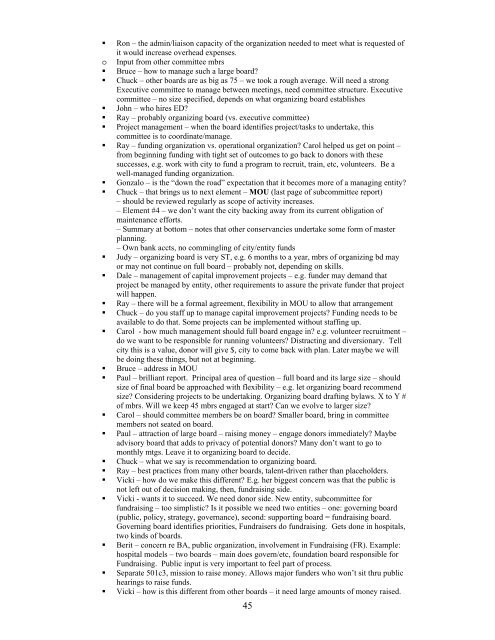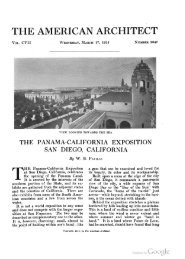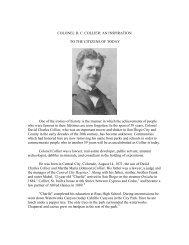The Future of Balboa Park - Committee of One Hundred
The Future of Balboa Park - Committee of One Hundred
The Future of Balboa Park - Committee of One Hundred
You also want an ePaper? Increase the reach of your titles
YUMPU automatically turns print PDFs into web optimized ePapers that Google loves.
• Ron – the admin/liaison capacity <strong>of</strong> the organization needed to meet what is requested <strong>of</strong><br />
it would increase overhead expenses.<br />
o Input from other committee mbrs<br />
• Bruce – how to manage such a large board?<br />
• Chuck – other boards are as big as 75 – we took a rough average. Will need a strong<br />
Executive committee to manage between meetings, need committee structure. Executive<br />
committee – no size specified, depends on what organizing board establishes<br />
• John – who hires ED?<br />
• Ray – probably organizing board (vs. executive committee)<br />
• Project management – when the board identifies project/tasks to undertake, this<br />
committee is to coordinate/manage.<br />
• Ray – funding organization vs. operational organization? Carol helped us get on point –<br />
from beginning funding with tight set <strong>of</strong> outcomes to go back to donors with these<br />
successes, e.g. work with city to fund a program to recruit, train, etc, volunteers. Be a<br />
well-managed funding organization.<br />
• Gonzalo – is the “down the road” expectation that it becomes more <strong>of</strong> a managing entity?<br />
• Chuck – that brings us to next element – MOU (last page <strong>of</strong> subcommittee report)<br />
– should be reviewed regularly as scope <strong>of</strong> activity increases.<br />
– Element #4 – we don’t want the city backing away from its current obligation <strong>of</strong><br />
maintenance efforts.<br />
– Summary at bottom – notes that other conservancies undertake some form <strong>of</strong> master<br />
planning.<br />
– Own bank accts, no commingling <strong>of</strong> city/entity funds<br />
• Judy – organizing board is very ST, e.g. 6 months to a year, mbrs <strong>of</strong> organizing bd may<br />
or may not continue on full board – probably not, depending on skills.<br />
• Dale – management <strong>of</strong> capital improvement projects – e.g. funder may demand that<br />
project be managed by entity, other requirements to assure the private funder that project<br />
will happen.<br />
• Ray – there will be a formal agreement, flexibility in MOU to allow that arrangement<br />
• Chuck – do you staff up to manage capital improvement projects? Funding needs to be<br />
available to do that. Some projects can be implemented without staffing up.<br />
• Carol - how much management should full board engage in? e.g. volunteer recruitment –<br />
do we want to be responsible for running volunteers? Distracting and diversionary. Tell<br />
city this is a value, donor will give $, city to come back with plan. Later maybe we will<br />
be doing these things, but not at beginning.<br />
• Bruce – address in MOU<br />
• Paul – brilliant report. Principal area <strong>of</strong> question – full board and its large size – should<br />
size <strong>of</strong> final board be approached with flexibility – e.g. let organizing board recommend<br />
size? Considering projects to be undertaking. Organizing board drafting bylaws. X to Y #<br />
<strong>of</strong> mbrs. Will we keep 45 mbrs engaged at start? Can we evolve to larger size?<br />
• Carol – should committee members be on board? Smaller board, bring in committee<br />
members not seated on board.<br />
• Paul – attraction <strong>of</strong> large board – raising money – engage donors immediately? Maybe<br />
advisory board that adds to privacy <strong>of</strong> potential donors? Many don’t want to go to<br />
monthly mtgs. Leave it to organizing board to decide.<br />
• Chuck – what we say is recommendation to organizing board.<br />
• Ray – best practices from many other boards, talent-driven rather than placeholders.<br />
• Vicki – how do we make this different? E.g. her biggest concern was that the public is<br />
not left out <strong>of</strong> decision making, then, fundraising side.<br />
• Vicki - wants it to succeed. We need donor side. New entity, subcommittee for<br />
fundraising – too simplistic? Is it possible we need two entities – one: governing board<br />
(public, policy, strategy, governance), second: supporting board = fundraising board.<br />
Governing board identifies priorities, Fundraisers do fundraising. Gets done in hospitals,<br />
two kinds <strong>of</strong> boards.<br />
• Berit – concern re BA, public organization, involvement in Fundraising (FR). Example:<br />
hospital models – two boards – main does govern/etc, foundation board responsible for<br />
Fundraising. Public input is very important to feel part <strong>of</strong> process.<br />
• Separate 501c3, mission to raise money. Allows major funders who won’t sit thru public<br />
hearings to raise funds.<br />
• Vicki – how is this different from other boards – it need large amounts <strong>of</strong> money raised.<br />
45







